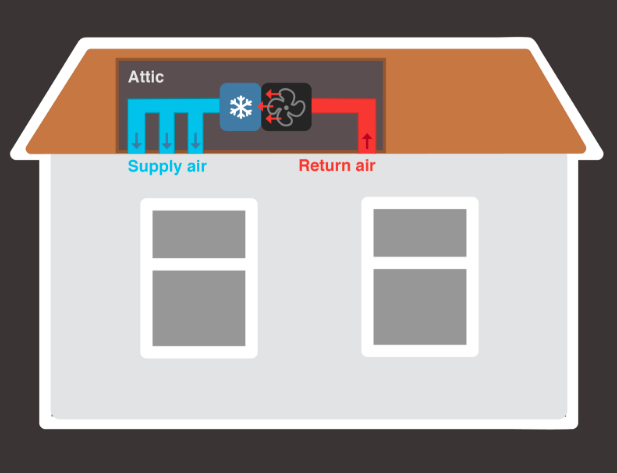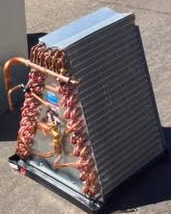Why Is My Air Filter Wet?
October 02, 2017

Does your HVAC air filter feel damp or completely soaked?
Well, first you’ll want to replace your air filter.
A wet air filter can’t clean your air very well, and can quickly become a breeding ground for mold and mildew. (And no one wants mold spores entering their home’s air.)
So, where is that moisture coming from? Well, it’s actually coming from your AC. You see, in normal operation your AC system produces moisture. But that moisture should never come into contact with your air filter—unless there’s a problem.
AC problems that result in a wet air filter include:
- Clogged condensate line (the most likely problem)
- Leaky drain pan
- Frozen evaporator coil
We’ll explain each of those problems (and how to fix them). But first let’s take a closer look at why your AC produces moisture in the first place...
Why your AC produces moisture
Your air conditioner has 2 jobs:
- To cool your home’s warm air
- To remove moisture from the humid air

A diagram of how your AC system works: Return air is cooled and dehumidified, then it enters your home through the supply vents.
When your home’s warm, humid air enters your return vents, it travels through the ductwork until it gets to the evaporator coil, the A-shaped component that’s responsible for cooling and dehumidifying your home’s air. The coils in the evaporator are filled with refrigerant—a cold liquid that’s designed to absorb heat and moisture from the air.

An evaporator coil
As the evaporator coil extracts moisture from the air, beads of water form and drip off the coils into a drain pan. As you might guess, the “drain” pan sits directly underneath the evaporator coil and is designed to collect all the moisture your AC produces.
The drain pan is connected to a pipe called a condensate line, which transports that moisture out of your home.

An example of an air handler. Because the air filter is so close to the evaporator coil and drain pan, water can easily get onto the filter if there’s a problem.
Now, if there are problems with any of those 3 main components, then water can escape and soak the area around your air handler—including your air filter.
Let’s take a look at some of those problems...
Problem #1: Clogged condensate line
A clogged condensate line is the most likely cause of a wet air filter. We’ll explain why it gets clogged and how to fix it.
Why your condensate line gets clogged
Gunk from a clogged condensate drain line
Your condensate line runs from your indoor air handler to the outdoors (where it dumps moisture). But because the condensate drain line is exposed to outdoor weather, strong winds and storms often kick up dirt and debris that can clog up the condensate drain line (see picture above).
Signs your condensate line is clogged
- Water on the floor near the air handler
- Musty odors and increasing humidity inside your home
- Water isn’t dripping from the white PVC condensate drain line outside your home
How to fix it
Follow these steps to clear your condensate line:
- Find your condensate drain line exit
- Connect a wet/dry vacuum to the condensate line opening
- Run the vacuum for 10–15 seconds. Repeat until the clog is removed
Don’t have a wet/dry vacuum? Or need a professional’s help clearing your condensate line? Give us a call.
Problem #2: Leaky drain pan
If your condensate line isn’t the issue, check your drain pan.
Your drip pan sits underneath your indoor air handler and collects the water that drains from your AC’s evaporator coils. Over time, these pans can crack or rust out, which causes water to escape and soak the surrounding area.
How to fix it
If your drip pan is leaky, go to a home improvement store and buy a replacement pan. Just tell the store clerk your AC’s brand and model and they’ll help you find a drain pan that fits your system. When you get home, just slide in the new drain pan under the air handler where the old one was.
Not sure what size and model drain pan you need? Just contact a professional to replace it for you.
Problem #3: Frozen evaporator coil
A frozen evaporator coil
If your condensate line is clear and your drip pan is in good condition, then you may have a frozen evaporator coil.
A frozen evaporator coil is usually caused by low airflow or a refrigerant leak. Basically, these 2 problems cause the temperature of the evaporator coil to drop, which freezes the condensation (moisture from your home’s warm air).
Want to learn more about why your evaporator coil freezes? Read our article “Why Is My Air Conditioner Frozen on the Inside?”
So, what does a frozen evaporator coil have to do with your wet air filter? Well, in between cooling cycles (when your AC isn’t operating), all that ice on the evaporator coil melts. And since there’s so much water, it will often overflow from the drain pan and leak onto surrounding surfaces, including your air filter.
Signs you have a frozen evaporator coil:
- Warm air coming from your vents
- Longer cooling times than normal
- Higher energy bills
- Ice on refrigerant lines
How to fix it
Follow these steps to troubleshoot a frozen evaporator coil:
- Check for low airflow problems: Make sure ALL of your home’s vents are open (even in unused rooms) and make sure your air filter isn’t dirty. This will help your AC get enough air so it can run properly.
- Look for signs of a refrigerant leak: Do you hear a hissing sound? Or does your AC run longer than normal? If so, you should contact a professional to find and repair your refrigerant leak.
Want to learn more about refrigerant leaks? Read our articles:
Need help from a Fort Myers professional?
Contact Advanced Air to schedule an appointment with one of our trained HVAC technicians. We’ll find and fix whatever is causing your air filter to get wet.
- Posted in:
- Air Conditioning

